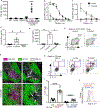Identification of a T follicular helper cell subset that drives anaphylactic IgE
- PMID: 31371561
- PMCID: PMC6901029
- DOI: 10.1126/science.aaw6433
Identification of a T follicular helper cell subset that drives anaphylactic IgE
Abstract
Cross-linking of high-affinity immunoglobulin E (IgE) results in the life-threatening allergic reaction anaphylaxis. Yet the cellular mechanisms that induce B cells to produce IgE in response to allergens remain poorly understood. T follicular helper (TFH) cells direct the affinity and isotype of antibodies produced by B cells. Although TFH cell-derived interleukin-4 (IL-4) is necessary for IgE production, it is not sufficient. We report a rare population of IL-13-producing TFH cells present in mice and humans with IgE to allergens, but not when allergen-specific IgE was absent or only low-affinity. These "TFH13" cells have an unusual cytokine profile (IL-13hiIL-4hiIL-5hiIL-21lo) and coexpress the transcription factors BCL6 and GATA3. TFH13 cells are required for production of high- but not low-affinity IgE and subsequent allergen-induced anaphylaxis. Blocking TFH13 cells may represent an alternative therapeutic target to ameliorate anaphylaxis.
Copyright © 2019 The Authors, some rights reserved; exclusive licensee American Association for the Advancement of Science. No claim to original U.S. Government Works.
Figures







Comment in
-
Interleukin-13 Is Unlucky for Allergy Sufferers.Trends Pharmacol Sci. 2019 Oct;40(10):714-716. doi: 10.1016/j.tips.2019.08.007. Epub 2019 Sep 5. Trends Pharmacol Sci. 2019. PMID: 31493932
References
-
- Mita H, Yasueda H, Akiyama K, Affinity of IgE antibody to antigen influences allergen-induced histamine release. Clin. Exp. Allergy : journal of the British Society for Allergy and Clinical Immunology 30, 15831589 (2000); published online EpubNov ( - PubMed
-
- Wang J, Lin J, Bardina L, Goldis M, Nowak-Wegrzyn A, Shreffler WG, Sampson HA, Correlation of IgE/IgG4 milk epitopes and affinity of milk-specific IgE antibodies with different phenotypes of clinical milk allergy. The Journal of allergy and clinical immunology 125, 695 702 e691–702 e696 (2010); published online EpubMar (10.1016/j.jaci.2009.12.017). - DOI - PMC - PubMed
-
- He JS, Subramaniam S, Narang V, Srinivasan K, Saunders SP, Carbajo D, Wen-Shan T, Hamadee N. Hidayah, Lum J, Lee A, Chen J, Poidinger M, Zolezzi F, Lafaille JJ, de Lafaille M. A. Curotto, IgG1 memory B cells keep the memory of IgE responses. Nat Commun 8, 641 (2017); published online EpubSep 21 (10.1038/s41467-017-00723-0). - DOI - PMC - PubMed
Publication types
MeSH terms
Substances
Grants and funding
LinkOut - more resources
Full Text Sources
Other Literature Sources
Medical
Molecular Biology Databases
Miscellaneous

